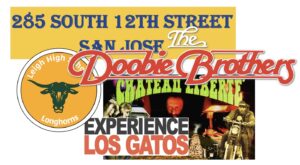12th Street House Band
The humble origins of San Jose's first Rock Hall of Famers
March 19, 2021 By Gary Singh, Metro
Special Thanks
At present, there’s an effort underway to designate the home where Tom Johnston lived, concurrent with the formation of The Doobie Brothers, as a historic landmark in the City of San Jose. Thank you Gary for contributing your thoughts on the house, the band, and band’s connection to San Jose and Silicon Valley.
12th Street House Band
Patrick Simmons of The Doobie Brothers is now the only Leigh High School graduate in the Rock & Roll Hall of Fame. As the Doobies roll into 2021, the band’s 50th anniversary tour is scheduled to unfold later this year, after being postponed due to the Coronavirus. In the meantime, the moment is right for San Jose to contemplate the origins of its most favorite local band.

It all began in downtown San Jose, as the free lovin’ 1960s unfurled into the biker-clad 1970s, at least in the Doobies’ case. As the story goes, in a series of events, Skip Spence, formerly of the Jefferson Airplane and Moby Grape, helped introduce The Doobie Brothers to each other. Following a gig at the Gaslighter Theater in Campbell, Spence introduced Patrick Simmons to future bandmates Tom Johnston and John Hartmann, who were already living at 285 S. 12th Street in San Jose’s Naglee Park neighborhood, just a few blocks from San Jose State University. The house soon doubled as the band’s headquarters. Johnston’s heavy blues-influenced guitar worked well with Simmons’ finger-picking techniques and knack for vocal harmonies, both of which fueled much of the band’s songwriting in the early days.
Although their first album did not exactly explode onto the charts, its cover featured a black and white photo of the Doobies at Chateau Liberte, a notorious biker bar up in the mountains above Los Gatos. “The Chateau” as it came to be known, was not a button-down teetotaler’s kind of place. Bikers, drunks, dealers, hippies and all sorts of mountain folk regularly turned the place into a raging party. Located on a muddy dirt path off Old Santa Cruz Highway, The Chateau was buried amid the gargantuan redwoods. Since the building was down the hill from the main road and somewhat difficult to reach, the sheriffs often just refused to drive all the way in. The Doobies regularly played at the bar and it became one of the places that launched them into local prominence. Other bands like Hot Tuna and the earliest version of The Tubes also put in legendary time at Chateau Liberte.
Another place key to the Doobies’ humble beginnings was Ricardo’s Pizza at 218 Willow Street. Operated by Richard Quisenberry and featuring classic decor of red-and-white checkerboard tablecloths, wooden chairs and Italian accoutrements, Ricardo’s was a popular neighborhood hangout that also catered to legends like trumpeter Chet Baker. Extra seating existed upstairs above the kitchen, and a small stage sat near the opposite wall. For what now seems like a brief moment in time, the Doobie Brothers were essentially the house band.
As the early ‘70s unfolded, the Doobies continued to live, party and write music out of the 12th Street house. After the not-so-successful debut, the band conceived most of its follow-up, Toulouse Street, while living on 12th Street. Their basement was a near-perpetual jam session, at least according to the stories Johnston and Simmons have told over the years. Today, as one walks by the house — on a quiet residential side street — one can almost hear the music playing 50 years ago.
As Johnston said during his Rock & Roll Hall of Fame acceptance speech, the band is not done yet. Here’s to 50 more years!
A Related Story
===
Gary’s Picks
Over the decades, Johnston and Simmons have told numerous stories about the original days, but here are two specific conversations in which they get into the details.
About Gary Singh

Gary Singh is a journalist with a music degree, a published poet and a long-time newspaper columnist at Metro Silicon Valley. His byline has appeared over 1400 times in various consumer and trade publications, including travel essays, art and music criticism, profiles, business journalism, lifestyle articles, poetry and short fiction. He is the author of The San Jose Earthquakes: A Seismic Soccer Legacy (2015, The History Press) and was recently a Steinbeck Fellow in Creative Writing at San Jose State University. At Leigh High School, he had the same auto shop teacher at Patrick Simmons, although 20 years later. Learn more about Gary Singh at GarySingh.info
On Sale Now!
Silicon Alleys: Selected Metro Columns, 2005-2020, By Gary Singh
![]()
In 2005, the editors of Metro Silicon Valley, San Jose’s alternative weekly newspaper, gave Gary Singh his own column, “Silicon Alleys,” to explore the underbelly of San Jose from a perspective only a creative native could offer. To this day, he still writes the column every week. Now a selection of Gary’s greatest hits, over 250 columns in chronological order, is available in one mammoth volume, hand-picked by the columnist. Following a gnarly foreword by cyberpunk science fiction pioneer Rudy Rucker, a glorious mishmash of humanity emerges. UFO researchers sit right alongside rock stars, repo men and professional wrestlers. Buddhist scholars hold column space with women’s drinking clubs. Abandoned strip malls return to life. From punk rock to high art, from dive bars to luxury digs, from literary vibes to forgotten history, no other body of work more aptly sorts out the guts of America’s 10th largest city than Gary’s weekly column.
